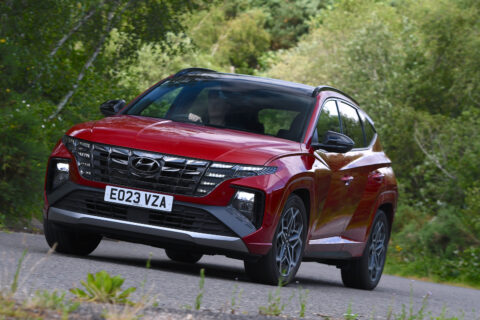
The Tucson’s interior is as admirably designed and striking as the exterior, with a large swathe running from one door, across the dashboard, to the other door, broken by a swoop into the centre console. The air vents are cleverly hidden within it, too.
There are two digital displays. The 10.25in instrument cluster looks like a large smartphone has been propped up behind the steering wheel, but in a world where unfathomable and over-complex displays have become so tempting for manufacturers because they can, Hyundai has instead stuck with the eminently sensible choice of two large round dials – with warnings appearing over one of them if needed.
Centrally, there’s a touchscreen of the same 10.25in size, with a bunch of buttons beneath it and, thankfully, separate controls for the climate control and then, lower still, even more clearly marked buttons for the likes of heated seats and steering wheel and parking sensors.
It suggests some thought has gone into it: the higher the controls, and therefore the closer to your natural eye line on the road, the more ‘touchscreeny’ they become. Real, physical buttons, evidently the easiest way to find and operate something, are still the choice for hard-to-see places. This is worth noting for manufacturers who insist on burying everything within touchscreen menus.
The front seats are broad and comfortable, fabric-fronted and none the worse for it, being attractively stitched. Rear passengers do just as well, with decent head and leg room and, although the width of the centre passenger’s perch is restricted in any car, there’s a broad armrest when there are just two aboard, or the entire centre section can fold. The seat doesn’t just split and fold 40/20/40, but it also has various stages of recline, handy if your youngsters want to doze off.
Behind all of that is a competitively sized, 616-litre boot with a broad opening and largely plastic, durable-looking sides, although a few extra hooks and catches wouldn’t hurt.
Hyundai Tucson infotainment and sat-nav
As so many manufacturers have, Hyundai has put its infotainment system within a touchscreen but it isn’t too troubling to use by global standards. The system is pretty straightforward to navigate, the graphics are clear and, if it’s all a bit much, there’s Android Auto and Apple CarPlay so you can fall back on phone mirroring.
Front and rear occupants get USB sockets and satellite navigation is standard, as is Hyundai’s Bluelink connected system, which has real-time traffic, parking and fuelling (and for EVs, charging) information. Drivers link it to an app on their phone for info when they’re not in the car.
Premium trim and range-topping Ultimate models gain a boot-mounted subwoofer and a wireless phone charging pad.
